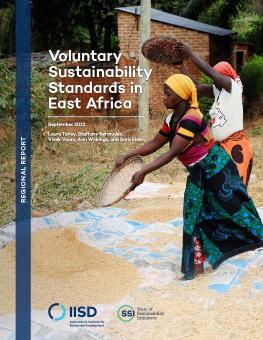
Voluntary Sustainability Standards in East Africa
How can adopting voluntary sustainability standards for staple crop production help achieve key East African policy objectives?
Agriculture is a pillar of the economy in East Africa, employing as much as 80% of the population and representing 25% of GDP. Expanding the sector has great potential to improve livelihoods and bring widespread prosperity to people in the region.
Partner States of the East African Community (EAC)—Burundi, Kenya, the Democratic Republic of the Congo, Rwanda, South Sudan, Tanzania, and Uganda—are pursuing regional agricultural objectives, as defined in policies developed by the EAC that seek to:
- Maintain and increase agricultural productivity
- Overcome trade barriers to improve intra-regional trade
- Build resilience to climate change.
IISD’s State of Sustainability Initiatives’ first regional report, Voluntary Sustainability Standards (VSSs) in East Africa, shows that adopting standards to produce staple crops like beans, maize, rice, and wheat can help achieve these regional policy objectives while protecting vital ecosystems, managing scarce resources efficiently, and supporting workers' livelihoods and rights. There is a great opportunity to use VSSs to sustainably increase the production and trade of staple crops in East Africa. Importantly, smallholder farmers stand to benefit from this growth—they form a large part of the supplier base and depend on staple crops for livelihoods and personal consumption. At the same time, such growth will reduce import dependency in the region.
This research shows that sustainability standards can:
- Incentivize climate-resilient practices, such as improving soil quality, using water more efficiently, integrating agro-forestry practices, and facilitating ecosystem restoration.
- Help increase productivity among staple crop producers—for instance, by improving crop handling and storage practices so farmers can deal with mold contamination that threatens crops and by supporting access to high-quality inputs and related training.
- Facilitate intraregional trade by encouraging producers to comply with relevant laws and regulations and by encouraging alignment between other standards and best practices—for instance, through their criteria on managing pests, disease outbreaks, and targeted chemical use.
Accordingly, the report includes recommendations for VSS bodies, the EAC, and its Partner States to support the use of standards to achieve sustainable agricultural growth in harmony with nature and communities. Publication Type
You might also be interested in
How Can We Work With Nature to Tackle Drought and Desertification?
Drought is one of the most devastating and pervasive challenges exacerbated by climate change. However, we can work to reduce its effects through nature-based solutions for land restoration and climate-smart agriculture.
Global Market Report: Soybean prices and sustainability
Less than 3% of soybeans are produced in compliance with sustainability standards. This report unpacks what needs to change to make soybeans a food that protects rather than harms the natural environment.
Global Market Report: Tea prices and sustainability
This report explores recent market trends in the tea sector and explains why we need to get better at recognizing the social and environmental costs of tea production.
South-South Trade and Voluntary Sustainability Standards
This report explores how voluntary sustainability standards are being used in trade policy to increase the trade of more sustainable products between developing countries.